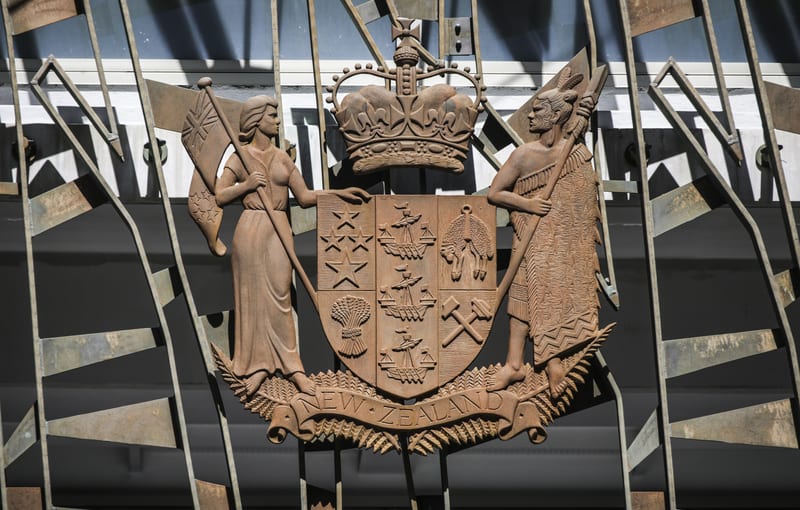A detective who was part of the team re-investigating the Red Fox Tavern shooting and robbery has detailed the extensive enquiries police made about a man who was ultimately ruled out as a suspect.

Photo: RNZ / Rebekah Parsons-King
Father of two Chris Bush, 43, was gunned down at the pub in Maramarua in October 1987, and the offenders took off with tens of thousands of dollars in cash, coins and cheques.
Mark Hoggart and another man - who has name suppression - are on trial in the High Court at Auckland, charged with murder and aggravated robbery.
They deny the charges and say police arrested the wrong men.
Detective Senior Sergeant Michael Hayward was one of the officers involved in the re-investigation of the homicide, dubbed Operation Lion, which began in 2016.
In his evidence, Hayward said there were 230 people considered persons of interest in the original investigation, which wound down in mid-1988 without anyone being charged. Another investigation which began in 1999 also failed to result in arrests.
However, the two men on trial were considered prime suspects in those earlier investigations, Hayward said.
They were arrested and charged in 2017 as a result of new evidence and further investigation as part of Operation Lion.
Hayward said the police file for the Red Fox Tavern was large and mostly paper-based - he estimated it was the size of about 100 large lever-arch files, but it appeared complete.
He said the Operation Lion team started with no preconception of who was responsible.
In addition to reviewing the evidence against the two defendants, they also reviewed all of the other persons of interest to make their own assessment of whether that person could be considered a suspect or had been eliminated, Hayward said.
"I was ultimately satisfied it was appropriate to charge the defendants with murder and aggravated robbery and that none of the other nominations [persons of interest] affected that assessment," he said.
"In relation to other persons nominated or investigated, I formed the view that many had been nominated without cause, i.e. without evidence, sometimes on no more than a hunch, and sometimes even maliciously."
There were 20 large files of information relating to other persons of interest, Hayward said. Among them was Lester Hamilton, who died in 2003.
Hayward said Hamilton was one of the key lines of inquiry for police in 1987 and his name had continued to crop up as a person of interest in years since.
However, Hayward said he was ultimately eliminated as a suspect.
The original investigation team discovered that Hamilton and some of his associates had committed a number of crimes, mostly burglaries, in the Hauraki Plans and Thames area in the months before the Red Fox Tavern shooting and robbery, Hayward said.
They had also talked about and even planned other robberies in the area.
In late June or early July 1987, some of Hamilton's associates told police Hamilton had discussed a robbery of the Red Fox Tavern, Hayward said.
One of those associates said Hamilton's plan was to take the manager hostage at his house on a Sunday night, taking him to the pub and getting him to open the safe.
If the manager refused, the offenders would cut one of the wife's toes off, Hayward said.
The reason they chose Sunday was that the tavern served meals that day and there would be more money in the safe, Hayward said.
Hamilton's associates told police nothing came of the plan and one said it was dropped after one of their houses was searched in September 1987.
At the same time, Hamilton had been involved in a scheme to import morphine from India, to turn into homebake heroin.
That drug importation investigation, and the one into the Red Fox Tavern homicide, became interwoven, Hayward said.
Hayward said Hamilton may have initially lied about his whereabouts on the night of the Red Fox Tavern shooting, because he was trying to cover up an affair.
"Additionally, Hamilton seems to have courted police attention either because he wanted the notoriety of being a prime suspect for the murder, or because he was not behaving rationally because of his heavy drug use at the time," Hayward said.
The jury also heard details about a number of prisoners who came forward to police in subsequent years, claiming Hamilton had confessed to his involvement in the Red Fox Tavern homicide, while he was serving jail time for his role in the drug importation ring.
Hayward said those confessions were not deemed to be credible and Hamilton was "big-noting about a crime he had no responsibility for".
There had been rumours in prison that Hamilton and one of his associates were the prime suspects for the crime, Hayward said.
In 1991 and 1992, Hayward said police investigated a claim by one prisoner that Hamilton and one of his associates had confessed their part in the crime to him.
But Hayward said the police concluded confessions were fabricated by the prisoner, to engineer his transfer to a lower-security prison.
Hayward said the prisoner was an associate of Roberto Conchie Harris - the secret prison informant known as 'witness C', who gave evidence at David Tamihere's 1990 murder trial and was later convicted of perjury.
That case was explicitly mentioned in detailed notes said to have been written after the alleged confessions and later provided to the police.
The trial before Justice Woolford and a jury of five women and seven men continues.


